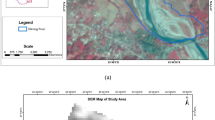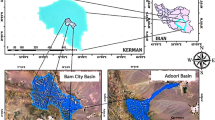Abstract
Flood is the devastating natural events as it causes massive destructive of life, economy and infrastructure. The main objective of this study was flood inundation mapping using HEC-RAS model: the case of Awash Bello flood plain, Upper Awash River basin, Ethiopia. River geometry, annual peak flood, and boundary conditions are the most important input parameters for RAS preprocessing. The river cross-sections along the flood plain were extracted using HEC-Geo RAS. Annual peak flood frequency analysis for different recurrence intervals (i.e., 2, 5, 10, 25, 50, and 100 years) was computed using the calibrated and validated HEC-HMS model based on a 25 years (1990–2015) hydro-meteorological data collected from Ministry of Water Resources Irrigation and Electricity and National Meteorological Agency, respectively. The model result depicted the flood extreme value for the respective recurrence interval was 526, 610, 828.8, 1072.8, 1263.6, and 1461.3 m3/s, respectively. For more reliability, the HEC-HMS model outputs were compared with the flood extreme value obtained from Log Pearson type-III, General Pareto and Gumbel extreme value distribution function and it was found the HEC-HMS model result for every recurrence interval was higher than the extreme value distribution function outputs. After verifying the acceptability of the HEC-HMS model result, the verified peak flood was inserted into HEC-RAS model and flood inundation mapping for different recurrence intervals were executed. The HEC-RAS model outcome indicated that the flood inundation mapping area for 2, 5, 10, 25, 50, and 100-year recurrence intervals, respectively, was 71.475, 76.630, 89.150, 100.290, 105.160, and 109.462 km2. Finally, it was realized that the whole Awash Bello flood plain is under the influence of flood inundation due to the intensive rainfall event.













Similar content being viewed by others
Explore related subjects
Discover the latest articles and news from researchers in related subjects, suggested using machine learning.References
Abon CC, Kneis D, Crisologo I, Bronstert A, David CPC, Heistermann M (2015) Evaluating the potential of radar-based rainfall estimates for streamflow and flood simulations in the Philippines. J Geo Nat Hazards Risk 9:1–16
Adams TE, Pagano TC (2016) Flood forecasting: a global perspective. Elsevier
Aris MM (2003) GIS modelling for river and tidal flood hazards in waterfront city: case study in samurangu city, Java Indonsia. ITC
Banks JC, Camp JV, Abkowitz MD (2014) Adaptation planning for floods: a review of available tools. J Nat Haz 70(2):1327–1337
Dale M, Wicks J, Mylne K, Pappenberger F, Laeger S, Taylor S (2012) Probabilistic flood forecasting and decision-making: an innovative risk-based approach. J Nat Haz 70(1):159–172
Dos Santos PP, Tavares AO (2015) Basin flood risk management: a territorial data-driven approach to support decision-making. Water 7(2):480–502
Gashaw W, Legesse D (2011) Flood hazard and risk assessment using GIS and Remote Sensing in Fogera Woreda Northwest Ethiopia. Nile River Basin, Spri. pp. 179–206.
Getahun YS, Gebre SL (2015) Flood hazard assessment and mapping of flood inundation area of the awash river basin in ethiopia using GIS and HEC-Geo RAS/HEC-RAS model. J Civil Environt Eng 5(4):1–12. https://www.hilarispublisher.com/abstract/flood-hazard-assessment-and-mapping-of-flood-inundation-area-of-the-awash-river-basin-in-ethiopia-using-gis-and-hecgeora-30899.html
Goodell C, Warren C (2016) Flood inundation mapping using HEC-RAS. Obras y Proyectos, pp 18–23
Jazuri A, Nur SM, Nur AMS (2016) Estimation of peak discharges using flood frequency analysis and hydrological modeling system. Springer
Kania DN, Yeonsu K, Kwansue J, Hyunuk A (2015) Application of rainfall-runoff-inundation (RRI) model for inundation case in upper. Proc Eng 125:166–172
Kefeyale A (2003) Integrated flood management case study Ethiopia. Addiss Abeba
Martini F, Loat R. (2007) Handbook on good practices for flood mapping in Europe. European change circle on flood mapping. https://ec.europa.eu/environment/water/flood_risk/flood_atlas/pdf/handbook_goodpractice.pdf
Merz B, Thieken AH, Gocht M (2007) Flood risk mapping at the local scale: concepts and challenges. J Flood Risk Manag 25:231–251. https://doi.org/10.1007/978-1-4020-4200-3_13
Narayan N, Swastik B, Mofuzur R, Kyle W, Ajay K, Sajjad A, Ritu G (2018) Flood frequency analysis using generalized extreme value distribution and floodplain mapping for Hurricane Harvey in Buffalo Bayou. Am Soc Civil Eng. https://doi.org/10.1061/9780784481400.034
Niraj L, Suresh S (2017) Development of flood warning system and flood inundation mapping using field survey and LiDAR data for the grand river near the City of Painesville. Ohio J Hydrol 4(24):1–15. https://doi.org/10.3390/hydrology4020024
Noor SR, Zulkifli YAI (2018) Application of HEC-RAS and Arc GIS for floodplain mapping in segamat town Malaysia. Internat J Geomate 14(43):125–131
Pedro G, Inês M, Alberto G (2015) Flood hazard, Santa Cruz do Bispo Sector, Leça River, Portugal: a methodological contribution to improve land use planning. J Maps 11(5):760–771. https://doi.org/10.1080/17445647.2014.974226
Permatasari R, Natakusumah DK, Sabar A (2017) Determining peak discharge factor using synthetic unit hydrograph modelling (Case Study: upper Komering South Sumatera, Indonesia). Internat J Geomate 13(36):1–5
Santillan JR, Amora AM, Makinano-Santillan M, Marqueso JT, Cutamora LC, Serviano JL, Makinano R (2016) Assessing the impacts of flooding caused by extreme rainfall events through a combined geospatial and numerical modelling approach. The International Archives of the Photogrammetry Remote Sensing and Spatial Information
Santos PP, Tavares AO, Zeˆzere JL (2014) Risk analysis for local management from hydro-geomorphologic disaster databases. Environ Sci Policy. https://doi.org/10.1016/j.envsci.2013.12.007
Sanyal J, Lu XX (2005) Remote sensing and GIS-based flood vulnerability assessment of human settlements: a case study of Gangetic West Bengal. Hydrol process
Shakirudeen O, Saheed AR (2014) Flood frequency analysis and inundation mapping of lower ogun river basin. J Water Res Hydr Eng 3(3): 48–59.https://www.researchgate.net/publication/281067413
Sintayehu V (2015) Application of the HEC-HMS model for runoff simulation of upper blue nile River Basin. J Hydrol Curr Res 2(6):1–8. https://doi.org/10.4172/2157-7487.1000199
Son CH, Baek JI, Ban YU, Ha SR (2015) The effects of mitigation measures on flood damage prevention in Korea. Sustainability 7(12):16866–16884
Usace (2016) HEC-RAS river analysis system, Hydraulic reference manual v 5.0
Wisner B, Blaikie P, Cannon T, Davis I (2004) Natural hazards people’s vulnerability and disasters. Routlege
Yirga KW (2016) Flood hazard and risk assessment using GIS and remote sensing in lower awash sub-basin, Ethiopia. J Environ Earth Sci 6(9): 69–86. https://iiste.org/Journals/index.php/JEES/article/download/32924/33820
Acknowledgements
Without the financial support from the Jimma University, Jimma Institute of Technology, it would not be possible to complete the study. Therefore, we, the authors, are grateful to the Jimma University, Jimma Institute of Technology for the financial support.
Author information
Authors and Affiliations
Corresponding author
Additional information
Publisher's Note
Springer Nature remains neutral with regard to jurisdictional claims in published maps and institutional affiliations.
Rights and permissions
About this article
Cite this article
Namara, W.G., Damisse, T.A. & Tufa, F.G. Application of HEC-RAS and HEC-GeoRAS model for Flood Inundation Mapping, the case of Awash Bello Flood Plain, Upper Awash River Basin, Oromiya Regional State, Ethiopia. Model. Earth Syst. Environ. 8, 1449–1460 (2022). https://doi.org/10.1007/s40808-021-01166-9
Received:
Accepted:
Published:
Issue Date:
DOI: https://doi.org/10.1007/s40808-021-01166-9




